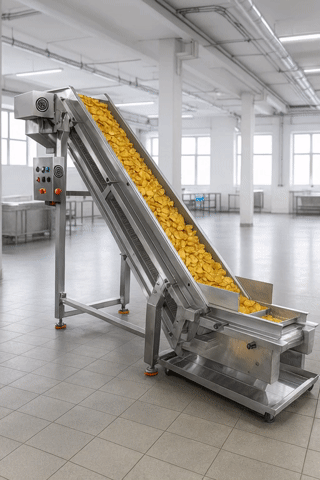In the food production and processing industry, conveyor systems play a vital role in streamlining operations. However, if a food conveyor is not designed with hygiene in mind, it can become a breeding ground for bacteria and a source of cross-contamination. That’s why hygienic design for food conveyors is not just important—it’s essential. It directly affects product quality, consumer health, and a company’s reputation.
In this article, we’ll walk through the core aspects of sanitary conveyor design, focusing on material selection (stainless steel), ease of cleaning, e waterproof features. Whether you’re a food manufacturer, plant manager, or quality control expert, this guide will help you understand how smart design leads to safer food and smoother production.
1. Why Stainless Steel is the Ideal Material for Food Conveyors
One of the most critical decisions in transportador higiênico design is the material selection. Aço inoxidável, particularly grades 304 and 316L, is the gold standard for transportadores de qualidade alimentar. Here’s why:
- Corrosion Resistance: Food processing environments often involve acids, alkalis, and salts. Stainless steel resists corrosion, ensuring long-term durability and minimizing the risk of rust or material degradation.
- Easy to Clean: The non-porous, smooth surface of stainless steel prevents food particles and microbes from sticking. This supports thorough cleaning and sanitization routines.
- Durability: With excellent strength and impact resistance, stainless steel conveyors can withstand frequent wear and tear—reducing maintenance and extending service life.
- Regulatory Compliance: Stainless steel meets global food safety standards, including FDA regulations e EU directives for materials that come into contact with food.
- Industry Example: Many correias transportadoras de qualidade alimentar today use 304 or 316 stainless steel with polished surfaces and no dead corners. These designs fully comply with FDA hygiene requirements.

2. Easy-to-Clean Design: A Core Principle in Sanitary Conveyors
For a conveyor to be truly hygienic, it must be easy to clean and sanitize. A well-designed food conveyor can reduce cleaning time, lower water and detergent usage, and significantly cut down the risk of microbial contamination.
Key Design Considerations:
- No Dead Zones: Avoid flat horizontal surfaces, tight corners, gaps, or blind spots where food or water can collect. Cleanability improves when every part is accessible.
- Removable Components: Modular designs allow belts, guards, and covers to be disassembled quickly for thorough cleaning and maintenance.
- Smooth, Polished Surfaces: Scratches and cracks can harbor bacteria. Choose electropolished stainless steel for critical contact surfaces.
- Efficient Drainage: Incorporate sloped surfaces and drainage channels to let water flow away naturally during washdowns.
- Self-Cleaning Options: Some advanced polyurethane belt conveyors now come with integrated self-cleaning systems, further improving hygiene and efficiency.
Industry Insight: We have set high standards with conveyor systems that feature zero flat surfaces, effective drainage, and 100% accessibility for cleaning.

3. Waterproof Design: Protecting Electrical and Mechanical Integrity
In food plants, wet cleaning with high-pressure washers is routine. Without a waterproof design, electrical failures, equipment corrosion, and bacterial growth can occur.
Here’s how a waterproof conveyor system maintains both performance and hygiene:
- Sealed Enclosures: Use IP65-rated (or higher) seals around control boxes, motor housings, and junctions to prevent moisture ingress.
- Protective Covers: Shield key components with water-diverting guards and smart enclosure designs that keep water away from sensitive zones.
- Water-Resistant Materials: Non-metal parts (e.g., plastic or rubber components) should be food-grade, non-absorbent, and resistant to degradation.
- Quick Drying: Design systems to minimize moisture retention and promote fast drying after washdown to avoid microbial growth.
Hygienic design is the foundation of food safety. By using high-quality materials like stainless steel and incorporating easy-to-clean, waterproof features, food conveyor systems can significantly reduce contamination risks, increase operational efficiency, and comply with stringent food safety standards.
As a leading food conveyor manufacturer, we understand the critical role that hygienic design plays in your production process. Whether you’re upgrading your facility or looking for custom solutions, our team is here to help you meet your safety, compliance, and productivity goals.
👉 Have questions about choosing the right sanitary conveyor? Want a custom design for your production line? Leave a comment below or get in touch with our team—we’d love to hear from you!

